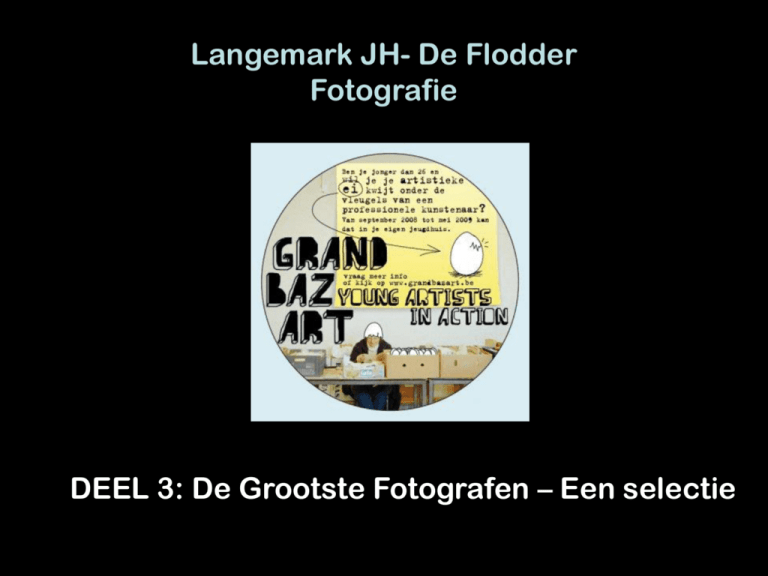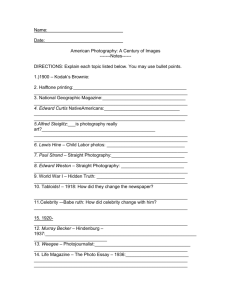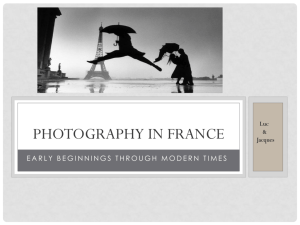Jacques Henri Lartigue
advertisement

Langemark JH- De Flodder Fotografie DEEL 3: De Grootste Fotografen – Een selectie • • • • • • • • • • • • • • • • • Joseph Nicéphore Niépce Alfred Stieglitz Edward Steichen Paul Strand Jacques Henri Lartigue Dorothea Lange August Sander Man Ray Ansel Adams Henri Cartier-Bresson Lewis Hine Weegee Elliot Erwit Edward Weston William Klein Arnold Newman W. Eugene Smith • • • • • • • • • • • • • • • • • • • Bill Brandt Robert Capa Robert Doisneau Jozef Koudelka Helmut Newton Diane Airbus Richard Avedon Guy Bourdin James Nachtwey Nan Goldin Cindy Sherman Martin Parr Gregory Crendson Rineke Dijkstra Carl De Keyzer Stephan Vanfleteren Alex Vanhee Tim Dirven Jimmy Kets Joseph Nicéphore Niépce Uitzicht vanuit werkkamer door lichtgevoelige asfaltlaag op tinnen plaat 8uur, 1826 Alfred Stieglitz "The Street--Design for a Poster," from Camera Work (1903) Portrait of a Woman, n.d. The Steerage1907 Edward Steichen The Flatiron (1905) Moonrise, 1904 Paul Strand Blind woman, New York, 1917 Jacques Henri Lartigue 1894- 1986 Jacques-Henri Lartigue began taking photographs when he was only 6 years old. He grew up near Paris, France during the turn of the 20th century. He did not establish his name by being a photographer, but as a painter. Most of his life he focused on painting being his full time job and photography was a hobby. He kept an open mind and was not influenced by the style other photographers of this time took on because it was only a hobby and he photographed for his own personal interest. Dorothea Lange “Migrant-Mother” "Destitute Pea Pickers in California. Mother of Seven Children. Age ThirtyTwo. Nipomo, California." February, 1936. America from the Great Depression to World War II: Black-and-White Photographs from the FSA-OWI, 19351945, Library of Congress. August Sander Man Ray “Violon d’Ingres”, 1924 Ansel Adams ca. 1930 Henri Cartier Bresson “Paris”, 1932 Lewis Hine "Power house mechanic working on steam pump," 1920 Weegee Weegee was the pseudonym of Arthur Fellig (June 12, 1899 – December 26, 1968), an American photographer and photojournalist, known for his stark black and white street photography. Elliot Erwitt Edward Weston William Klein “Broadway and 103 rd Street. New York” (1955) This picture is part of a collection which marked an important turning point in the history of photography in the second half of the 20th century. This collection was published in 1956 under the title “New York”. WILLIAM KLEIN, who at the time was living and working in Paris, returned to the city where he was born and with this collection about its street life turned the photographic genre on its head. Using a high-speed and therefore grainier film he introduced picture distortion and blurring without any hesitation. His compositions, complex and apparently without order, set them apart from existing canons. It resulted in an uncomfortable and crude photography that probably wanted to reflect the sensations that the city and the American way of life produced in him. A photography full of rage and a new way to express itself. The author himself commented with fine irony on his own technique, saying that it was “a crash course in what not to do in photography”. It’s rather curious that an artist trained in France, where there were so many good photographers at that time was so far from the perfectionism that characterised the French photographic style. American Vogue, April, 1960 W. Eugene Smith Cover of W. Eugene Smith's Let Truth Be the Prejudice. An example of W. Eugene Smith's war photography for Life. Tomoko in her bath, 1967 Bill Brandt Bill Brandt (May 3, 1904 – December 20, 1983) was an influential British photographer and photojournalist known for his high-contrast images of British society and his distorted nudes and landscapes. Robert Capa Capa is most famous for his photograph of a Spanish Republican militiaman, right, taken at the exact moment he was shot on a battlefield during the conflict. That photo and the rest of Capa's work transformed wartime photography. 1936 The Fallen Soldier Death of a Loyalist Soldier Robert Doisneau Le Baiser de l'Hotel de Ville, Paris, 1950 Robert Doisneau was the ultimate storyteller. His pictures, well versed in the laws and lines of photographic communication, became synonymous with a way of life that we all now accept as ‘French’. Who cannot recall the image of the two lovers walking past the Hôtel de Ville, in a passionate embrace, or the iconic image of Picasso sitting at his breakfast table, his hands miraculously metamorphosed into bread rolls! L’Enfer bôite de nuit, Place Pigalle, Paris 1952 Josef Koudelka ca. 1960 Helmut Newton Self-Portrait with Wife and Model, Vogue Studio, Paris, 1981 Jeanloup Sieff Guy Bourdin Diane Airbus Child with Toy Hand Grenade, Central Park, N.Y.C., 1962 Richard Avedon Nastassja Kinski and the Serpent, June 14, 1981 James Nachtwey "I have been a witness, and these pictures are my testimony. The events I have recorded should not be forgotten and must not be repeated." -James Nachtwey- • Nan Goldin Cindy Sherman Unititled Film Still #14, 1978 Cindy Sherman Untitled #132, 1984 Martin Parr from Common Sense 1995-1999 Gregory Crewdson Rineke Dijkstra Carl De Keyzer Stephan Vanfleteren www.stephanvanfleteren.com Alex Vanhee www.alexvanhee.be Tim Dirven www.timdirven.com Jimmy Kets http://jimmykets.wordpress.com/









